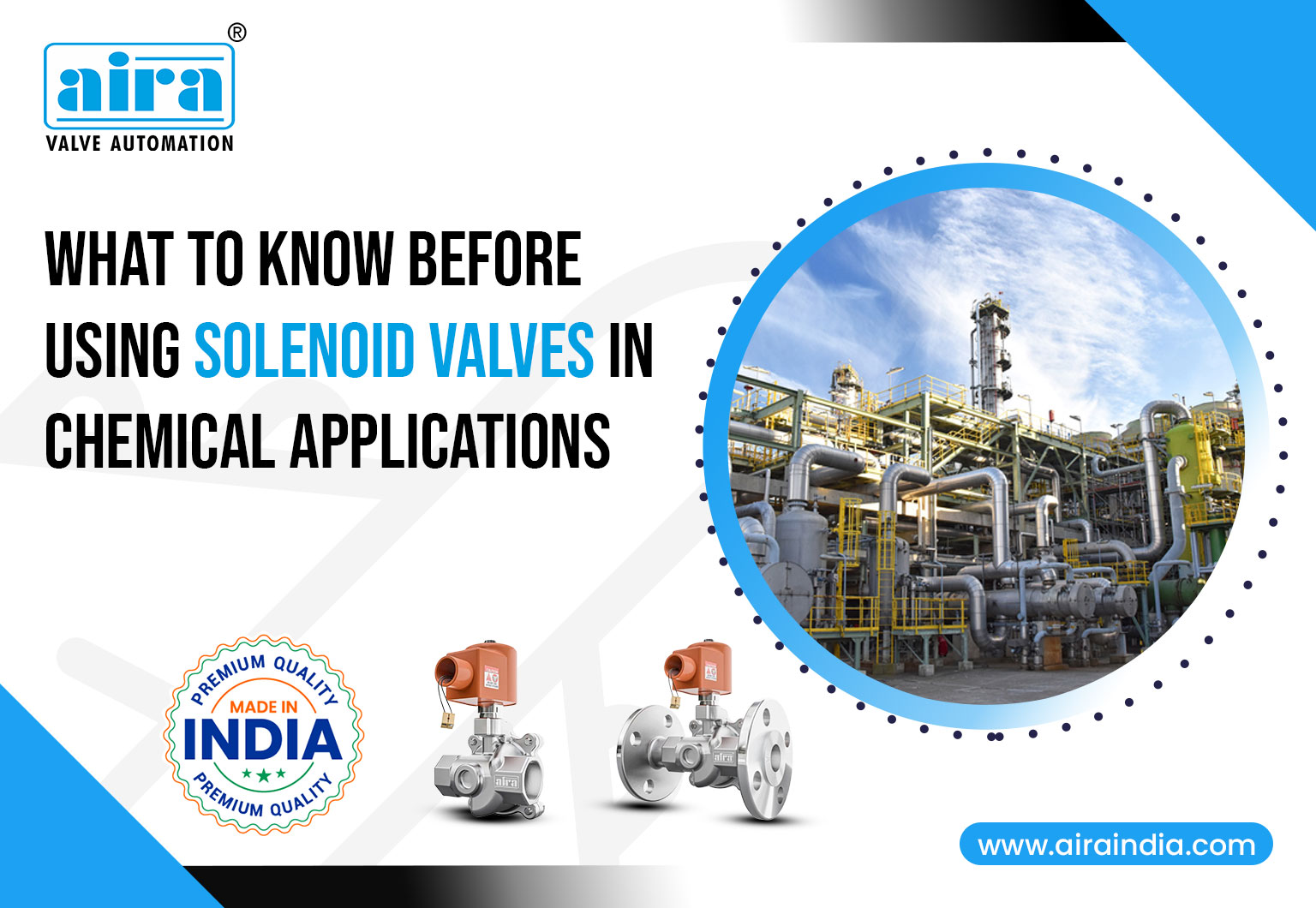In modern chemical plants, solenoid valves are everywhere, controlling dosing pumps, regulating transfer lines, and ensuring precise flow management in reactors and storage tanks. But when the wrong valve is installed, the consequences can be severe.
A mismatched material can corrode within weeks, seals can swell and leak, and your system could face hazardous spills or unplanned downtime. For chemical applications, choosing the right solenoid valve isn’t just a purchase decision; it’s a safety and performance necessity. This guide from Aira Euro Automation highlights what you need to check before installing solenoid valves in any chemical process.
Know Your Media: Chemical Compatibility First
Before thinking about price or lead time, focus on chemical compatibility. Every process fluid has unique characteristics, and not all solenoid valves are suitable for every chemical.
Start by identifying
- The exact chemical name (e·g·, hydrochloric acid, sodium hypochlorite, ethanol)
- Its concentration in your process
- Operating temperature and line pressure
Once you have these details, refer to the chemical compatibility charts provided by a trusted valve manufacturer, such as Aira Euro Automation. For example, brass valves quickly degrade in most acids, while SS316 handles many solvents but may still fail with certain chlorides· Using the wrong combination can lead to swollen seals, corroded internals, and unexpected leakage.
Always match your valve’s materials to the media. If in doubt, speak directly to the manufacturer’s engineering team for guidance on chemical‑compatible valve materials.
Selecting the Right Materials
In chemical applications, material selection is the heart of valve reliability. At Aira Euro Automation, we recommend focusing on both body and seal materials to ensure long‑term resistance to aggressive media.
Body Materials to Consider
- SS316: Excellent for many acids, alkalis, and solvents
- Hastelloy: Exceptional for oxidizing agents and high‑temperature acids
- PTFE‑lined bodies: Ideal for ultra‑corrosive media
- PVDF: Lightweight yet resistant to many chemicals
Seal Materials
- EPDM: Good for many water‑based chemicals
- FKM (Viton): Handles many oils, fuels, and mild solvents
- PTFE: The best option for harsh or high‑temperature chemicals
Avoid brass or aluminum in aggressive acid or chlorinated environments. Also, ensure the diaphragm quality is tested for chemical resistance and that the coil insulation can withstand your temperature range. For critical installations, explore fire‑safe and high pressure solenoid valve options to meet safety codes.
Design & Construction Considerations
A chemical process often has unique system dynamics, so look beyond materials and evaluate the valve’s design:
- Direct acting vs· pilot operated: Choose based on pressure range. For low pressure or no differential, use direct acting or zero differential designs.
- Zero differential types: Ideal for gravity-fed tanks or when the pressure drop across the valve is minimal.
- Coils & enclosures: In hazardous zones, use flameproof or explosion‑proof coils. For areas exposed to corrosive gases, select enclosures that are IP‑rated or sealed.
- Maintenance: Aggressive media can cause a build-up. Aira Euro Automation recommends scheduling periodic flushing or cleaning to maintain reliable operation.
By paying attention to design, you ensure your chemical-resistant solenoid valve performs consistently, even in challenging environments.
Also, read Solenoid Valve in Pharmaceutical Industry
Pressure, Temperature & Flow Compatibility
Chemicals often behave differently when exposed to elevated temperatures or high pressure. That’s why verifying your solenoid valve’s specifications against actual operating conditions is critical.
- Pressure Rating: If the valve is underrated, seals can blow out under pressure. If it’s heavily overrated, you may overspend on unnecessary features.
- Temperature Limits: High temperatures can degrade seals quickly, so check compatibility for your specific chemical and operating temperature.
- Flow Requirements: Some processes demand variable flow. In such cases, consider a solenoid valve with an adjustable orifice to fine‑tune performance.
Application Examples
- Sodium hypochlorite dosing in water treatment
- Hydrochloric acid transfer in chemical processing
- Ethanol control in pharmaceutical production
Each scenario requires a careful match between valve specs and system conditions to avoid downtime.
Certification, Testing & Safety Standards
In chemical applications, safety and compliance cannot be overlooked. Always check that your chosen solenoid valve meets relevant certifications and is backed by stringent testing procedures.
Look for CE and SIL certifications for added safety assurance.
Confirm that the manufacturer conducts leak testing, hydrostatic pressure testing, and material traceability on every batch.
Aira Euro Automation maintains in‑house quality assurance and deep expertise in chemical application valves, ensuring every product meets international standards.
While cost is always a factor, never compromise on certifications or testing in sensitive chemical environments· A lower-priced, uncertified valve can cost far more in repairs, downtime, or compliance penalties later.
Conclusion
Selecting a solenoid valve for chemical use is not guesswork. By understanding your media, choosing the right body and seal materials, matching pressure and temperature ratings, and confirming certifications, you can ensure safe and efficient operation.
Aira Euro Automation offers a wide range of chemical-resistant solenoid valves with proven performance in demanding chemical environments.
Need guidance on choosing the safest solenoid valve for your chemical process?
Contact us today to get your free quote.
